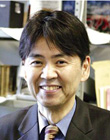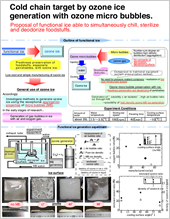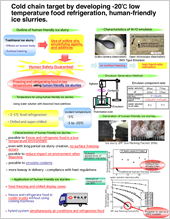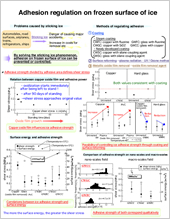 Index
Index

Koji Matsumoto [Profile]
Education Cource
Ice is hot now!!
Koji Matsumoto
Professor of Thermal Engineering, Faculty of Science and Engineering, Chuo University
Development of new functional ice and ice slurries.
—aiming to create an effective food refrigeration "cold chain (chilled transport)" —
With the high-functionalizing of high-precision equipment such as computers, discharge of internal heat and temperature regulation for high precision processing of parts has become extremely important. Furthermore, in order to enact the social keywords of "efficient energy use" and "reduce the impact on the environment", the establishment of heat storage technology and waste liquid disposal technology has become an important and urgent topic. Also, the development of freeze-preservation and defrosting technology of human organs and foodstuffs are also important and urgent topics, and heat-related knowledge is crucial here. While these are only the tip of the iceberg, there are currently many situations like this with heat (heat transfer phenomenon) related issues, and "heat transfer engineering" is essential to solving those issues. And, I believe, investigations from a heat engineering position will became vital and indispensible within an extended area including cutting-edge technology.
In regards to this matter, at our research laboratory we have been conducting research into the well-known ice thermal storage systems seen in the "eco-ice" commercials. Electric power demand is unevenly skewed toward the daytime. It is estimated that the propagation of ice thermal storage systems using nighttime power, with the aim of standardizing additional electric power, can reduce Japan's CO2 production by 620,000 tons, making this a highly useful technology in reducing the impact on the environment. We are also developing new functional ice and ice slurries with the aim of creating an effective cold chain (refrigerated preservation and transportation of foodstuffs). Furthermore, with the development of a thin film designed to regulate adhesive strength in the sticking phenomenon which occurs on the solid surface of ice on macro and micro nanoscales, elucidating the relation between the form / distribution of frost and the scraping power of frost, and by establishing waste liquid disposal and freeze-concentration of foodstuff technology which controls the direction of ice crystallization, we have made the heat transfer phenomenon the subject of research over a wide area.
Our research laboratory has exhibited its research content for six straight years at Innovation Japan, Japan's largest trade fair introducing university research, and moreover, we have conducted joint research with numerous businesses.
Introduction of research examples
(1) Cold chain target by ozone ice generation with ozone micro bubbles
Currently, it has been determined that ozone water, ozone gas with sterilization and deodorizing properties dissolved in water, is effective in freshness preservation of perishables, and its use is expanding. But, over time ozone is resolved into oxygen, and in regards to safety, it is difficult to maintain that effect. That is where, with the aim of ozone preservation and a cooling effect, we injected ozone gas into micro bubbles in ice and developed ozone ice, establishing an effective cold chain (preservation and transport of fresh food), and reforming the food distribution system.
(2) Cold chain target by developing -20℃ low temperature food refrigeration, human-friendly ice slurries
Ice thermal storage systems are mainly used in air conditioning of large-scale buildings. But there is a gap of 5-7℃ between the melting point of ice and the coolant required for air conditioning, so it can be considered that the cold energy of ice is more suited to food refrigeration than air conditioning. That is where we propose expansion of ice and ice slurries for food refrigeration.
(3) Basic research into adhesion regulation on frozen surface of ice
The sticking phenomenon of ice arises in many situations ranging from our everyday lives to the engineering field. In regards to sticking ice, in many cases adhesive strength regulation is desirable, but in recent years, with an expansion in the use of ice, attention has been focused on technology increasing adhesive strength. There, we have looked into various methods to regulate adhesive strength.
Outlook for the future
Ice is a substance extremely close to us, but it can store an enormous amount of cold energy without being a burden to the environment. Because of this, for example, ice thermal storage as a thermal storage method in the low energy consumption, highly effective CO2 management heat pump system known as "Eco Cute", we can expect more expansion in the future. In connection to this type of ice usage, from September 2010, centered mainly on this laboratory, an academia-business joint research project was started. In the project, various high-functioning ice and ice slurries will be developed to promote the expansion of ice and ice slurry food refrigeration, with the aim of creating a cold chain (fresh food preservation and transportation system) with ice and ice slurries. Also, we aim to rapidly establish technology for ice sticking regulation and prevention to meet the high demands of many businesses.
- Koji Matsumoto
Professor of Thermal Engineering, Faculty of Science and Engineering, Chuo University - Born in Tottori Prefecture in 1956.Graduated from Shizuoka University Faculty of Engineering Mechanical Engineering Department in 1982. Completed his Doctorate at Tokyo Institute of Technology Graduate School of Engineering in 1990. Entered current position in 1998 after spending time as an assistant at Aoyama Gakuin University College of Science and Engineering Department of Mechanical Engineering and assistant professor at Miyazaki University Faculty of Engineering Department of Mechanical Systems Engineering. His research topics can be seen at the following link.
http://ir.c.chuo-u.ac.jp/researcher/expense/00016251.html
- Research Activities as a Member of Research Fellowship for Young Scientists (DC1), Japan Society for the Promotion of Science (JSPS) Shuma Tsurumi
- Important Factors for Innovation in Payment Services Nobuhiko Sugiura
- Beyond the Concepts of Fellow Citizens and Foreigners— To Achieve SDGs Goal 10 “Reduce Inequality Within and Among Countries” Rika Lee
- Diary of Struggles in Cambodia Fumie Fukuoka
- How Can We Measure Learning Ability?
—Analysis of a Competency Self-Assessment Questionnaire— Yu Saito / Yoko Neha - The Making of the Movie Kirakira Megane











